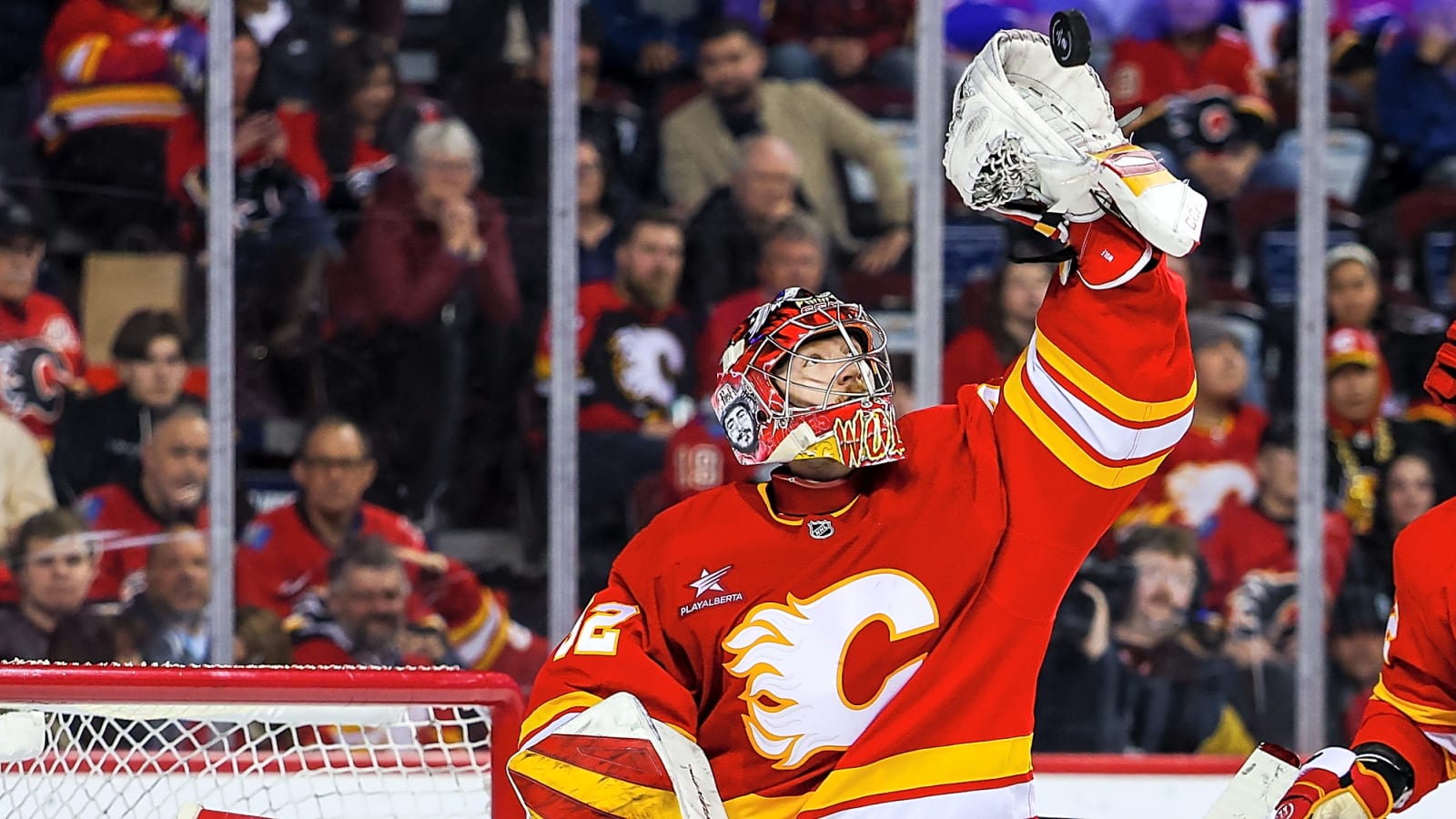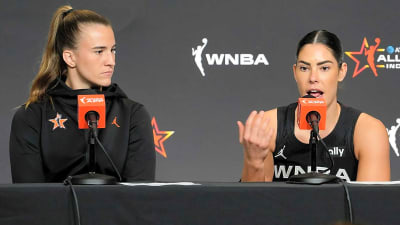
Dustin Wolf. It is no secret that the 24-year-old netminder is the main reason why the Calgary Flames even got close to making the playoffs last season. At every level of hockey he has played, he has silenced those who said he was too small and has been one of the best goaltenders. However, what makes Wolf so good between the pipes? Let’s break it down
Junior Career
AAA
Wolf is from Gilroy, California, and grew up a San Jose Sharks fan. However, he played his 13U-16U seasons with the Los Angeles Jr. Kings AAA teams. There he was putting up astounding numbers. Playing for the 13U AAA Jr. Kings, Wolf had a 1.33 goals against average with a .949 save percentage. The following year after at the 14U level, Wolf recorded a 2.99 goals against average with a .905 save percentage, also getting some games with the 16U team that season. He featured in just two games with the U16 team that year, but the following season posted a 1.63 goals against average along with a .941 save percentage.
WHL
After Wolf kept impressing, the Everett Silvertips selected him in the fifth round, 104th overall in the 2016 WHL Prospects Draft. This is where Wolf showed how good he really is. In a backup role during his first season, Wolf saw the ice on 20 occasions behind Carter Hart. In those appearances, he had a 13–6–0 record with a 2.25 goals against average and a .928 save percentage. The Silvertips saw enough in him, and the next season he was their starter and played 61 games with Hart moving up to the AHL and NHL.
In his first year as a starter, Wolf had no intent of slowing down, registering a record of 41–15–4, a 1.69 goals against average, and a .936 save percentage. The netminder won a plethora of awards in his first full season, including the Daryl K. Seaman Trophy as WHL Scholastic Player of the Year and CHL Scholastic Player of the Year. He was also named to the WHL West First All-Star Team.
The Silvertips made the postseason, and in 10 games, Wolf had a record of 5–5–0. He additionally had a 2.02 goals against average and a .914 save percentage. His goals against average and save percentage were the best in the WHL; however, he missed out on top goaltender. It was good enough to get him drafted by the Calgary Flames in the seventh round, 214th overall.
He took a bit of a step back the next season with a 34–10–2 record, a 1.88 goals against average, and a .935 save percentage. Wolf also made the USA’s World Junior team, where he made one appearance behind Spencer Knight. While the COVID-19 Pandemic shortened the season, it didn’t hamper Wolf’s development. He took home both the WHL Top Goaltender, the Del Wilson Trophy, and the CHL Goaltender of the Year. He also won yet another WHL West First All-Star Team nod and USA Hockey Junior Goalie of the Year: the Dave Peterson Award.
His final season in the WHL saw him go back to the World Juniors as well as playing a few games in the AHL. Another COVID-shortened season, Wolf only started in 22 games for the Silvertips, leading them to an 18–3–0 record. His 1.8 goals against average was an improvement on the year prior, and his .940 save percentage was the best in his WHL career.
His three games with the Stockton Heat, the then AHL affiliate of the Flames, marked the beginning of his pro hockey career. Wolf posted a 3.24 goals against average and a .895 save percentage, along with a 2–1–0 record. This small sample size was impacted by a brutal first game, in which he allowed five goals on 11 shots. Before making the step up to the pro level full-time, Wolf once again received the Del Wilson Trophy as the WHL’s top goaltender one last time.
Pro career
In the 2021–22 season, Wolf was a full-time pro hockey player. Playing 47 games for the Heat, Wolf had a 33–9–5 record. His 2.35 goals against average and .924 save percentage were enough for the Baz Batien Memorial Award, given to the AHL’s best goaltender for that season.
The Heat made the playoffs in their first season with Wolf as the starter. Through 13 games, Wolf went 8–5–0; he had a goals against average of 2.23 and a .929 save percentage with three shutouts to boot. Wolf was named to the AHL All-Rookie Team and the AHL First All-Star Team. He was named December AHL Goalie of the Month and finished the season with the most wins of any goalie.
If anyone hadn’t taken notice of Wolf yet, they sure did in the 2022–23 season. Starting for the Flames’ new AHL affiliate in the Wranglers, Wolf posted a record of 42–10–2, a 2.09 goals against average, and a .932 save percentage. Furthermore, he made the AHL All-Star Game and the AHL First All-Star Team. He also claimed most wins and shutouts in the AHL, along with the best goals against average and save percentage. He was named AHL Best Goaltender once again, received the AHL Best Goaltending Duo award (the Harry Holmes Memorial Award), and the AHL MVP (the Les Cunningham Award).
In nine postseason games, Wolf went 5–4–0 and had a save percentage of .912. Additionally, he had a goals against average of 2.67. Wolf also played in the Flames’ final game that season, against his hometown San Jose Sharks. Wolf allowed just one goal and had a save percentage of .958.
His final stint in the AHL during the 2023–24 season was again incredibly successful, and when he was needed, he got the call-up to play for the big team. In 36 games, Wolf had a 20–12–3 record, alongside a .922 save percentage and a 2.45 goals against average. Due to his time in the NHL, Wolf didn’t collect the hardware he was raking in previously. He became a two-time AHL All-Star for the Pacific division, and that was it. His 17 games with the Flames weren’t what he would’ve wanted, but they allowed him to fine-tune his game to elevate it and to be NHL-ready. 3.16 goals against average and a .893 save percentage with a 7–7–1 record. It made some fans shaky as to whether he was ready. Spoiler, he was.
This past season, with Jacob Markstrom gone, Dustin Wolf got his shot. 53 games as Calgary’s starter, and keeping them in games they had no business being in, Wolf was a sight to see for Flames fans. A 29–16–8 record and a .910 save percentage, he also had a 2.64 goals against average. Wolf was the main reason why the Flames finished the season on 96 points and missed the playoffs due to a tiebreaker. Heading into the year, they were projected to be a bottom-feeder. His performances caught everyone’s eyes and he was in the running for the Calder Trophy. While that didn’t come to fruition, he was the runner-up with 15 first-place votes. Wolf was also recognized on the NHL All-Rookie Team and was NHL Rookie of the Month for January. Not too shabby for a guy that’s ‘too small’.
A short career so far, with so much ahead of him. Wolf is one of the game’s most elite goalies, and he’s only 24 years old. The Flames and Flames’ fans now look forward to his future where he will most definitely continue to garner the accolades. Now that we’ve gone over his career, it’s time to look at how he’s defied the odds as a ‘smaller’ goalie.
Strengths
Leg power/Agility
It’s no secret that smaller goalies will be at a disadvantage. For them to make up for that strong leg power and elite agility is one of the few things that are needed. Dustin Wolf has both. Wolf moves between his crease quickly, which allows him to take away the bottom of the net. In doing so, he can get set up in his crease before the shot comes towards him. His lateral movement, his leg strength gives him that edge that he loses with his size.
Positioning/Athleticism
With that size disadvantage, Wolf makes up for it by taking up more of the net with his positioning. He tends to hang further out of his net to cut off angles. He can get lined up in front of the puck early, which allows him to square himself with it and take away more room. His athleticism also plays a major role in his game. Not only can he move quickly and get in front of pucks, he also uses his elite athleticism to stop high-danger chances like cross-crease plays.
Wolf models his game after former Los Angeles Kings netminder Jonathan Quick, who was known for his incredible athleticism. Instead of being a goalie who was just in the right place at the right time for pucks to bounce off of, Quick was known for his ability to get across the net well and be square to chances he should not have been. This trait is also reminiscent of former Flames netminder Miikka Kiprusoff.
Mental game
Being a goalie is more of a mental game than a physical one. Being able to shake off a bad game and get in front of your nerves separates good goalies from great ones. Wolf keeps his composure for an entire 60 minutes and keeps himself in the present moment. His self-proclaimed ‘jump for joy’ keeps him remembering why he plays this game. He is extremely intelligent, and his Hockey IQ makes it so that he makes the smart play.
Weaknesses
Size
Wolf’s biggest weakness that we have heard so much about is his size. At just 6’0″, Wolf is the second shortest goalie behind Juuse Saros. He has done a great job making up for his lack of size; however, this will almost always hang over him the same way it does for Saros. The only thing he can do is play bigger. Not being small in his net, and going out and making himself appear larger, and taking away more space.
Puck handling
The new generation of goalies isn’t playing the puck as much as the previous ones. It is something for them all to work on and improve, and Wolf is no different. Having that confidence to move out of your crease to move the puck is essential for any goaltender. For all of his faults, former Flames goalie Mike Smith was excellent at this and passed this trait on to other goalies in the organization. This is something that Wolf will need to work on as he grows his game.
Elevated shots
With a smaller frame, there will be issues, elevated shots being one of those. I’ve already mentioned how good Dustin Wolf is with the bottom of the net; the top of it is where he can be exposed sometimes. Challenging the shooter sometimes isn’t enough. Especially for Wolf, he sits lower, which is normal, but for someone of his stature, it puts more work on your glove. He has extremely quick reflexes, but by staying smaller in his net, he creates more work for himself, no matter how good his positioning is on the play. He has improved on this over his career and must continue to do so.
Wolf’s next steps
Wolf is still extremely young; he can continue learning and advancing his craft. This past season, we saw what he is capable of at the highest level. he got a third-place vote for the Vezina and a fourth-place vote for the Hart. He already is an integral part of this Flames team, putting them on his back on multiple occasions. If he works on ironing out his weaker points, such as the elevated shots and his puck handling, there is no reason why he doesn’t win one or more Vezinas in his career.
Stats courtesy of Elite Prospects
More must-reads:
- Alex Ovechkin provides update on extension talks with Capitals
- Diamondbacks GM makes his trade deadline hopes clear
- The 'NBA yearly field goals-per-game leader' quiz
Breaking News
Trending News
Customize Your Newsletter
 +
+
Get the latest news and rumors, customized to your favorite sports and teams. Emailed daily. Always free!








